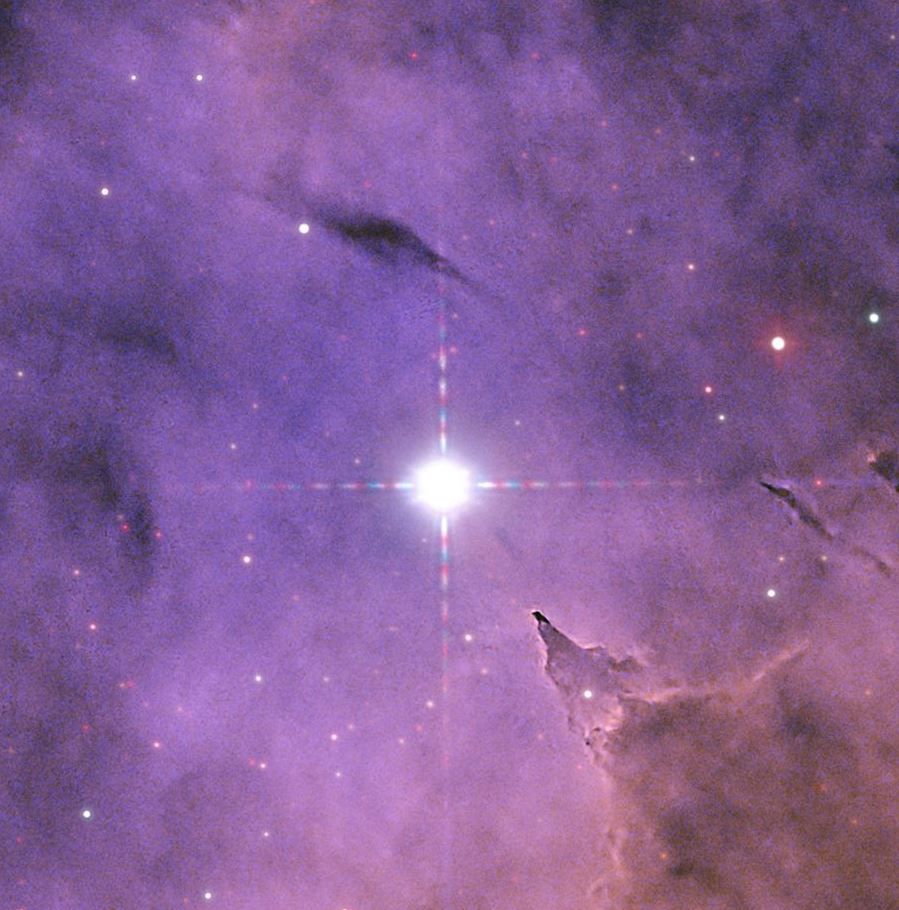I seem to be getting rainbow/dotted diffraction spikes when I shoot with my 8" Newt. I don't recall seeing them before and I can't spot the effect in the individual frames. Is it just down to my processing?

They don't bother me in the slightest, I'm just curious!
|
You cannot like this item. Reason: "ANONYMOUS".
You cannot remove your like from this item.
Editing a post is only allowed within 24 hours after creating it.
You cannot Like this post because the topic is closed.
Hello Piers,
diffraction is wavelength dependent. Hence the different waves produce at different places minima and maxima. That's what you see. The geometry is given by the geometry of the spider vanes.
CS
RÜdiger
|
You cannot like this item. Reason: "ANONYMOUS".
You cannot remove your like from this item.
Editing a post is only allowed within 24 hours after creating it.
You cannot Like this post because the topic is closed.
|
Thanks - I get the geometry (I rather like it!) but couldn't fathom why they were appearing "rainbowy". So it's just a result of how light works then!
|
You cannot like this item. Reason: "ANONYMOUS".
You cannot remove your like from this item.
Editing a post is only allowed within 24 hours after creating it.
You cannot Like this post because the topic is closed.
|
Thicker vanes produce that. Thinner vanes will be far less 'dotted' or rainbowy.
|
You cannot like this item. Reason: "ANONYMOUS".
You cannot remove your like from this item.
Editing a post is only allowed within 24 hours after creating it.
You cannot Like this post because the topic is closed.
|
Ah well, the R200SS has girders for vanes so that makes sense!
|
You cannot like this item. Reason: "ANONYMOUS".
You cannot remove your like from this item.
Editing a post is only allowed within 24 hours after creating it.
You cannot Like this post because the topic is closed.
|
I was getting this on my epsilon 160 and didn't really think of it until now. thanks for sharing!
|
You cannot like this item. Reason: "ANONYMOUS".
You cannot remove your like from this item.
Editing a post is only allowed within 24 hours after creating it.
You cannot Like this post because the topic is closed.
|
It doesn't matter the thickness as long it is an of order of magnitude greater than the wavelength of light. Mine are 0.5mm thick and they produce the same effect as well.
|
You cannot like this item. Reason: "ANONYMOUS".
You cannot remove your like from this item.
Editing a post is only allowed within 24 hours after creating it.
You cannot Like this post because the topic is closed.
|
All, are there any processing tricks to minimize the rainbow banding on the diffraction spikes in question? (just now processing and can't stop seeing them)
|
You cannot like this item. Reason: "ANONYMOUS".
You cannot remove your like from this item.
Editing a post is only allowed within 24 hours after creating it.
You cannot Like this post because the topic is closed.
Hi,
there is a freeware tool available to calculate diffraction effects. Spherofront.
I did some studies with that. The thinner the spider vanes are the less pronounced is the rainbow in the spikes. The Takahashis have relatively thick vanes. My newton has very thin vanes and the effect is barely visible. The other solution are curved vanes.
I don´t think there is a processing solution to get rid of the coluered spikes.
|
You cannot like this item. Reason: "ANONYMOUS".
You cannot remove your like from this item.
Editing a post is only allowed within 24 hours after creating it.
You cannot Like this post because the topic is closed.
Hi,
you can avoid the spikes by a special spider mask, like i used in this image here: https://www.astrobin.com/tgvhai/
but the mask produces larger stars, because the energy of the spider have to be distributed somewhere in the image.
|
You cannot like this item. Reason: "ANONYMOUS".
You cannot remove your like from this item.
Editing a post is only allowed within 24 hours after creating it.
You cannot Like this post because the topic is closed.
With narrow band you get separated dots. As you increase the band width, the dots connect to an almost continuous line once you get to full band.
The thicker the vanes, the more visible it is. You get the worst (most visible) with double vanes like in the Asa Newtonians, or other double vane scopes, like my home made newtonian.
Also you need bright stars to see the effect strongly.
Last diffraction spike can be remove at processing. Here is a way to do it which has received very little attention by the processing community, although it has been around for almost 5 years now.
|
You cannot like this item. Reason: "ANONYMOUS".
You cannot remove your like from this item.
Editing a post is only allowed within 24 hours after creating it.
You cannot Like this post because the topic is closed.
to create to post a reply.




